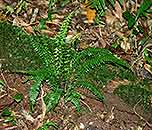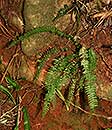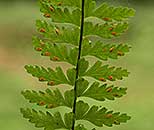Synonyms |
Asplenium erectum Bory ex Willd. var. usambarense (Hieron.) Schelpe
Asplenium sphenolobium (Kunze) Hieron. var. usambarense Hieron.
Asplenium usambarense (Hieron.) Hieron.
Asplenium zeyheri Pappe & Rawson
Asplenium lunulatum Sw. var. erectum (Bory ex Willd.) Sim
Asplenium quintasii Gandog.
|
Common name |
|
Description |
Rhizome erect, up to 13 mm thick; rhizome scales dark brown, entire to subentire, apex tapering to a point, up to 7 mm long. Fronds not proliferous, tufted, erect to arching.
Stipe subglabrous with sparse scales towards the base, up to 12 cm long, matt-grey-brown, with narrow green wings in the upper half.
Lamina variable, light to dark green, 12-40 cm × 1.8-5 cm, narrowly elliptic in outline, pinnate to 2-pinnatifid with decrescent basal pinnae. Pinnae variable, up to 3 × 1 cm, up to 30-45 pairs, shortly petiolate, margins irregularly toothed-lobed, incised less than 1/2 way to the midrib, midrib forming the lower margin of the pinnae for some distance, apex rounded to pointed, basal acroscopic lobe well developed and free, glabrous. Rhachis dark matt-grey to black with 2 narrow green wings, hairless.
Sori 6-15, linear to oval in outline, 1-5 mm long, set at an acute angle on both sides of the costa; indusium membranous,narrowly oblong, entire.
|
Notes | Differs from similar species by having 6-15 sori per pinna, reduced pinnae towards lamina base, not proliferous fronds.
Some autors recognize 2 varieties: var. erectum, which is narrowly oblong in outline and the basal auricle of the lower pinnae is not free, and var. usambarense , which is linear in outline and has a free basal auricle. |
|---|
Derivation | erectum: erect, upright; although the larger fronds are often arching.
|
|---|
Habitat | In deep shade on forest floor of evergreen forest.
|
|---|
Distribution worldwide | Africa, Madagascar, Mascarene Is. |
|---|
Distribution in Africa |
Burundi, Cameroon, Dem. Republic of Congo, Equatorial Guinea (incl. Bioko), Ethiopia, Ghana, Guinea, Kenya, Liberia, Malawi, Mozambique, Nigeria, Rwanda, South Africa, Sudan and South Sudan, Swaziland, Tanzania , Uganda, Zambia, Zimbabwe. |
Growth form |
Epiphytic, terrestrial. |
Literature |
Beentje, H.J. (2008) Aspleniaceae.Flora of Tropical East Africa, Pages 29 - 31. (Includes a picture).
Burrows, J.E. (1990) Southern African Ferns and Fern Allies. Frandsen, Sandton. Pages 223 - 224. (Includes a picture).
Crouch, N.R., Klopper, R.R., Burrows, J.E. & Burrows, S.M. (2011) Ferns of Southern Africa, A comprehensive guide. Struik Nature. Pages 606 - 607. (Includes a picture).
Fisher E. & Killmann D. (2008) Illustrated Field guide to the Plants of Nyungwe National Park Rwanda. University of Koblenz-Landau. Pages 72 - 73. (Includes a picture).
Fisher E. & Lobin W. (2024) Checklist of Lycopodiopsida (clubmosses and quillworts) and Polypodiopsida (ferns) of Rwanda.Willdenowia, 53 Page 156.
Fisher, E. & Lobin, W. (2023) Synoptic Revision of Aspleniaceae (Asplenium, Hymenasplenium) of Rwanda.Phytotaxa, 608 (1) Page 17.
Jacobsen, W.B.G. (1983) The Ferns and Fern Allies of Southern Africa. Butterworths, Durban and Pretoria. Pages 345 - 349. A. erectum and A. zeyheri considered as 2 different species. (Includes a picture).
Kornas, J. (1979) Distribution and ecology of the Pteridophytes in Zambia. Polska Akademia Nauk Wydzial II Nauk Biologicznych. Page 98.
Ntore, S. & al. (2024) Checklist of the vascular plants of Burundi. Meise Botanic Garden. Page 28.
Roux, J.P. (2001) Conspectus of Southern African Pteridophyta.Southern African Botanical Diversity Network Report, 13 Page 164. (Includes a picture).
Roux, J.P. (2009) Synopsis of the Lycopodiophyta and Pteridophyta of Africa, Madagascar and neighbouring islands. Strelitzia 23, South African National Biodiversity Institute, Pretoria. Pages 84 - 85.
Schelpe, E.A.C.L.E. (1970) Pteridophyta.Flora Zambesiaca, 0 Pages 175 - 176. (Includes a picture).
Tardieu-Blot, M.-L. (1964) Ptéridophytes vol.3.Flore du Cameroun, Page 198. (Includes a picture).
|



